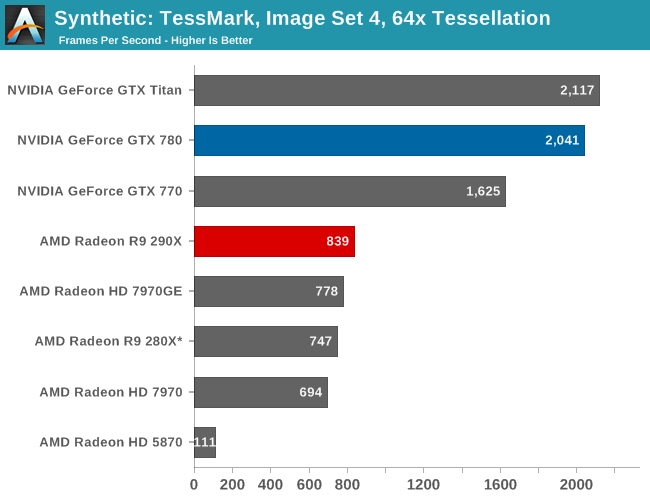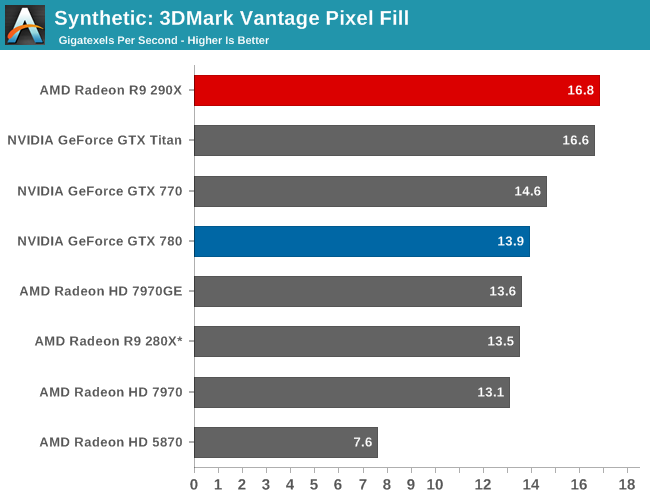The AMD Radeon R9 290X Review
by Ryan Smith on October 24, 2013 12:01 AM EST- Posted in
- GPUs
- AMD
- Radeon
- Hawaii
- Radeon 200
Synthetics
As always we’ll also take a quick look at synthetic performance. The 290X shouldn’t pack any great surprises here since it’s still GCN, and as such bound to the same general rules for efficiency, but we do have the additional geometry processors and additional ROPs to occupy our attention.

Right off the bat then, the TessMark results are something of a head scratcher. Whereas NVIDIA’s performance here has consistently scaled well with the number of SMXes, AMD’s seeing minimal scaling from those additional geometry processors on Hawaii/290X. Clearly Tessmark is striking another bottleneck on 290X beyond simple geometry throughput, though it’s not absolutely clear what that bottleneck is.
This is a tessellation-heavy benchmark as opposed to a simple massive geometry bencehmark, so we may be seeing a tessellation bottleneck rather than a geometry bottleneck, as tessellation requires its own set of heavy lifting to generate the necessary control points. The 12% performance gain is much closer to the 11% memory bandwidth gain than anything else, so it may be that the 280X and 290X are having to go off-chip to store tessellation data (we are after all using a rather extreme factor), in which case it’s a memory bandwidth bottleneck. Real world geometry performance will undoubtedly be better than this – thankfully for AMD this is the pathological tessellation case – but it does serve of a reminder of how much more tessellation performance NVIDIA is able to wring out of Kepler. Though the nearly 8x increase in tessellation performance since 5870 shows that AMD has at least gone a long way in 4 years, and considering the performance in our tessellation enabled games AMD doesn’t seem to be hurting for tessellation performance in the real world right now.
Moving on, we have our 3DMark Vantage texture and pixel fillrate tests, which present our cards with massive amounts of texturing and color blending work. These aren’t results we suggest comparing across different vendors, but they’re good for tracking improvements and changes within a single product family.

Looking first at texturing performance, we can see that texturing performance is essentially scaling 1:1 with what the theoretical numbers say it should. 36% better texturing performance over 280X is exactly in line with the increased number of texture units versus 280X, at the very least proving that 290X isn’t having any trouble feeding the increased number of texture units in this scenario.

Meanwhile for our pixel fill rates the results are a bit more in the middle, reflecting the fact that this test is a mix of ROP bottlenecking and memory bandwidth bottlenecking. Remember, AMD doubled the ROPs versus 280X, but only gave it 11% more memory bandwidth. As a result the ROPs’ ability to perform is going to depend in part on how well color compression works and what can be recycled in the L2 cache, as anything else means a trip to the VRAM and running into those lesser memory bandwidth gains. Though the 290X does get something of a secondary benefit here, which is that unlike the 280X it doesn’t have to go through a memory crossbar and any inefficiencies/overhead it may add, since the number of ROPs and memory controllers is perfectly aligned on Hawaii.










396 Comments
View All Comments
Blamcore - Friday, October 25, 2013 - link
Wow, I was just remarking yesterday that NV fanbois had sunk to the level of apple fanbois, when I was seeing the argument "you just like AMD because you can't afford NV" on a few boards. Now here is apple fanbois famous argument "my company is better because they have a higher profit margin" Gratz your unreasonable bias just went up a level!I know, you aren't a fanboy, you are really a business expert here to recommend that a company should gain market share by releasing a card roughly equal to what it's competitor had out for months and pricing it the same as they do! Maybe the could have asked 650 if they released it last January
puppies - Saturday, October 26, 2013 - link
R+D costs come from the sale price of the card. Are you tring to claim a $300 GPU costs $300 in materials? R+D costs also come from the fact that shrinking the process enables the manufacturer to get more cards per die each time.Look at Intel and AMD their chips don't go up in price each time they get faster, they stay at the same price point. The last 2 cards I have bought have been Nvidia but the next one will be AMD at this rate. I expect a 660TI to be faster and more energy efficient than a 560TI and at the same price point WHEN IT IS RELEASED and I think a lot of people are in the same boat. Nvidia is trying to push people into spending more each time they release a new model line up and it stinks.
I don't care if a 660 is faster than a 560TI, forcing people to move down the GPU lineup just smacks of NVIDIA price gouging.
Samus - Thursday, October 24, 2013 - link
I have to disagree with you Berzerker. Although his post clearly "overpromotes" the 290, it is incredible value when you consider it is faster and cheaper (by hundreds of dollars) than the Titan.-Geforce 660TI owner
Laststop311 - Thursday, October 24, 2013 - link
For people that value a quiet computer, this card is trashSpunjji - Friday, October 25, 2013 - link
For people that value a quiet computer, all stock coolers are useless.People that value a truly quiet computer won't even be playing at this end of the GPU market.
Samus - Friday, October 25, 2013 - link
This card is a great candidate for water cooling since the back of the PCB is essentially empty. Water cooling the face side is cheaper/easier, and this card can clearly use it.HisDivineOrder - Friday, October 25, 2013 - link
He didn't say "silent." He said "quiet." I'd argue the Titan/780/690 coolers were all "quiet," but not "silent."Since he said quiet, I don't think his expectation is unreasonable to expect a certain level of "quiet" at the $500+ range of discrete cards.
Nenad - Friday, October 25, 2013 - link
780 with stock cooler is not useless, and it IS quiet (it is not 'silent')BTW, going by posted numbers it seems 290x will be TWICE as noisy as GTX780 ?
ballfeeler - Thursday, October 24, 2013 - link
Methinks Berzerker7 is just salty and perhaps partial to nvidia. Nothing itchy wrote is inaccurate, including the $550 price that Salty-Berzerker7 claimed was $600.- Fastest card ? - yup
- Free game ? – yup
- Pooped all over titan ? –yup
Do not be salty mr. Berzerker7. AMD just roundhouse kicked nvidia square in the gonads with performance above Titan for half the price.
Shark321 - Thursday, October 24, 2013 - link
At 1080p it's actually slower than Titan if you average all reviews across the sites. With some reviews even slightly slower than the 780. It's also the loudest card ever produced after 30 minutes of playing (9,6 Sone in Battlefield 3 according to PCGamesExtreme). With this noise it's not acceptable and there will be no other coolers for the time being.